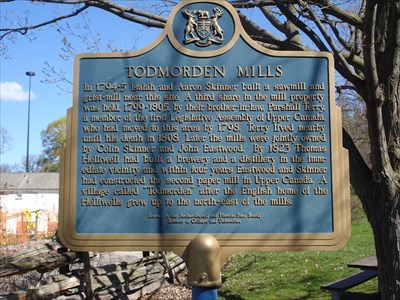
TODMORDEN MILLS
In 1794-5 Isaiah and Aaron Skinner built a sawmill and grist-mill near this site. A third share in the mill property was held, 1799-1805, by their brother-in-law, Parshall Terry, a member of the first Legislative Assembly of Upper Canada, who had moved to this area by 1798. Terry lived nearby until his death in 1808. Later the mills were jointly owned by Colin Skinner and John Eastwood. By 1823 Thomas Helliwell had built a brewery and a distillery in the immediate vicinity and within four years Eastwood and Skinner had constructed the second paper mill in Upper Canada. A village called "Todmorden" after the English home of the Helliwells grew up to the north-east of the mills.
From: Wikipedia
Todmorden Mills
Todmorden Mills was a small settlement located in the Don River valley in Toronto, Ontario. It started out as a lumber mill in the late 18th century. It grew into a small industrial complex and village before becoming part of East York in the 20th century. Currently the valley site is occupied by the Todmorden Mills Heritage Museum and Arts Centre, which includes the museum, art gallery, a theatre and a forest preserve.
History
In 1795, the settlement of York in Upper Canada was a small but growing community on the shores of Lake Ontario. In order to supply construction material, Lieutenant-Governor John Graves Simcoe granted land on the Don River to Aaron and Isaiah Skinner for the purpose of building a mill to supply lumber. Simcoe wrote to a friend "A mill should be build (sic) thereon". The mill was operated by the Skinners until about 1855 when it was sold to the Taylor family. In 1820 a brewery was built next to the mill and operated by Thomas Helliwell and John Eastwood. The Helliwell family operated it until 1855 when it too was sold to the Taylor family. Todmorden Mills acquired its name from John Eastwood, one of the original brewery owners. His family had emigrated from Todmorden, a town then straddling the two counties of Lancashire and Yorkshire in England.
The Taylors owned a number of industrial mills in the neighbourhood including the Don Valley Brick Works. Under their ownership the mill was converted to produce felt paper. The mill continued to operate until the 1920s when the building was converted into a riding stable.
In the early 1940s, the site became the location of a small German prisoner of war camp. The camp housed men from the German merchant marine who were interned in Allied ports at the start of the war. The prisoners often worked as labourers at the nearby Don Valley Brick Works. In 1945, the prisoners were repatriated and the camp was shut down. Soon afterwards, the camp buildings were destroyed by fire, likely set by vandals.
Between 1930 and 1967, the property housed a collection of horse riding schools and light industry. In the 1930s, the Windemere Riding Academy used the property. Don Vale Textiles occupied the property in the late 1940s. From 1950 and 1963, the Whitewood Riding School was housed at the stables.
During the building of the Don Valley Parkway, the site was extensively modified. The river which used to pass through the site in a wide meander was straightened so that it was entirely cut off from the site. The former riverbed was turned into a pond and the bridge that used to cross the river is now only used to reach a parking lot.
In 1965, the mill site was proposed as a centennial project by East York's mayor, True Davidson. On May 22, 1967 it was opened as the Todmorden Mills Historic Site and started to function as a community museum. Davidson remained as an honorary curator until her death in 1978. Currently the museum maintains four buildings from the original settlement including the old mill and brewery.
In 1991, two local naturalists, Charles Sauriol and Dave Money proposed that a small forested area adjacent to the museum site be turned into a nature preserve. A committee was formed and the Todmorden Mills Wildflower Preserve was created. Since then the committee has performed restoration in the forest to remove non-native invasive species and restore flowers and trees native to the Toronto area.